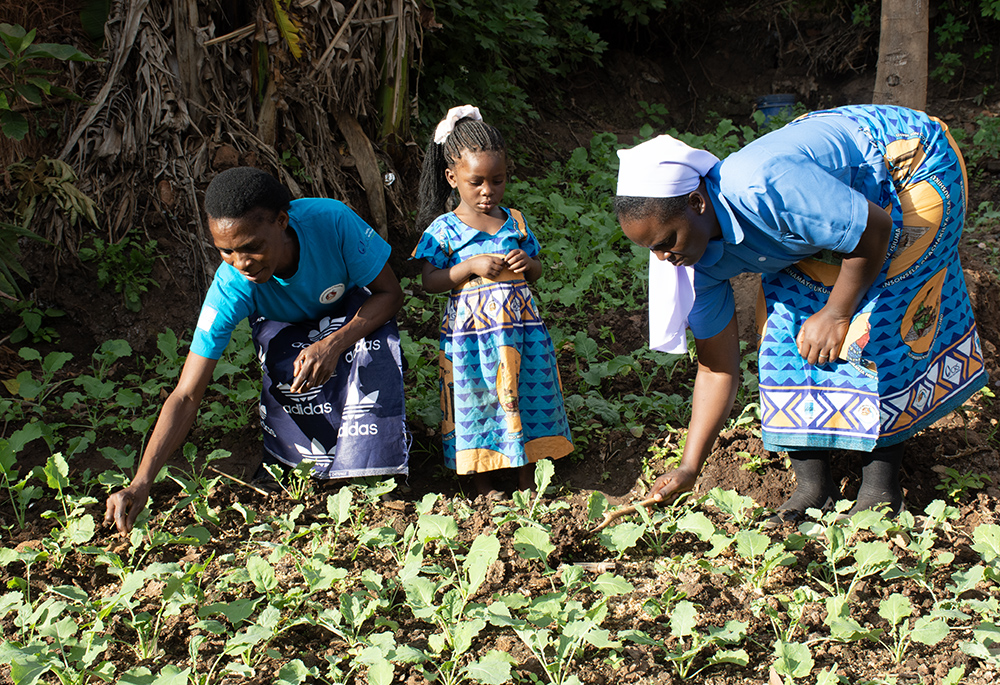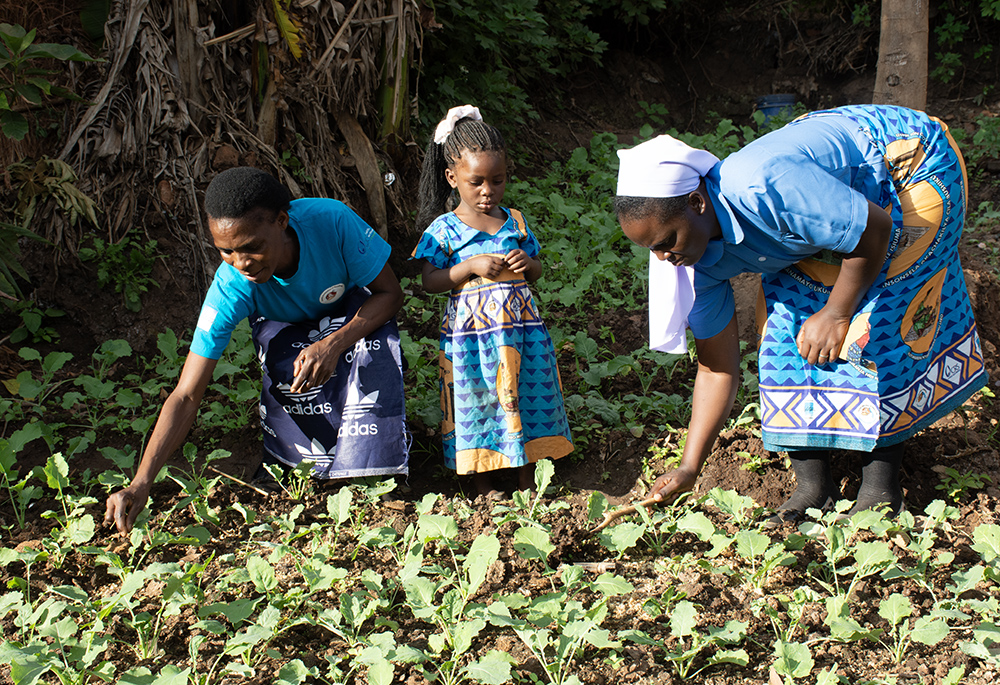Zambian sisters provide mothers with education on early childhood development – Global Sisters Report

Report on the SCORE-ECD Project’s Contribution to Sustainable Development Goals in Zambia
Project Overview and Alignment with SDG 17: Partnerships for the Goals
The Strengthening the Capacity of Religious Women in Early Childhood Development (SCORE-ECD) project in Zambia exemplifies a multi-stakeholder partnership (SDG 17) aimed at achieving critical development outcomes. The initiative leverages the community influence of religious sisters to deliver essential services.
- Objective: To improve the capacity of religious women to provide inclusive, high-quality, and nurturing care to children under five, with a focus on vulnerable populations.
- Key Partners:
- Funding: Conrad N. Hilton Foundation
- Coordination: Catholic Relief Services (CRS)
- Implementation: Association of Consecrated Women in Eastern and Central Africa (ACWECA) and the Zambia Association of Sisterhoods.
- Geographic Scope: The project is implemented across four Zambian provinces: Copperbelt, Luapula, Central, and Eastern.
Advancing SDG 2 (Zero Hunger) and SDG 3 (Good Health and Well-being)
The project directly addresses malnutrition and child health, making significant contributions to SDG 2 and SDG 3. By focusing on the critical early years, the initiative establishes a foundation for lifelong health.
- Tackling Malnutrition (SDG 2.2): Caregivers receive vital training on early childhood nutrition. This includes education on complementary feeding from six months using locally sourced, protein-rich foods such as groundnuts, soy, eggs, and beans. A case study from Kapata township documented a premature infant, Raphael Zimbili, whose weight increased from 1.4 kg to 8.2 kg following nutritional intervention and support.
- Improving Child Health (SDG 3.2): The project provides targeted support for low-birth-weight babies and educates mothers on effective breastfeeding techniques. This focus on neonatal and infant health is crucial for reducing preventable deaths in children under five.
- Holistic Development: The program integrates health, nutrition, and positive parenting support to ensure children develop to their full physical, emotional, and intellectual potential.
Promoting SDG 10 (Reduced Inequalities) through Inclusive Healthcare
A core principle of the SCORE-ECD project is its focus on reaching the most vulnerable and remote communities, thereby working to reduce inequalities in access to essential services.
- Reaching Vulnerable Populations: The project has directly benefited over 3,000 children and indirectly impacted nearly 2,500 others in underserved rural and slum areas.
- Support for Children with Disabilities (SDG 10.2): The initiative facilitates the early detection of developmental challenges. In one case, project staff helped identify hypotonic cerebral palsy in a two-year-old, Elias Tembo.
- Facilitating Access to Specialized Care: By connecting beneficiaries to specialized health services, such as the Cheshire Homes Society of Zambia, the project ensures that children with disabilities receive critical medical interventions. This led to a life-changing surgery for Elias, enabling him to sit and stand unaided.
Fostering SDG 5 (Gender Equality) and SDG 4 (Quality Education)
The project empowers women and provides foundational support for early learning, aligning with goals for gender equality and quality education.
- Women’s Empowerment (SDG 5): The program equips mothers, adolescent girls, and female caregivers with knowledge and skills, building their confidence and establishing them as leaders in their communities. This empowerment strengthens families and enhances community resilience.
- Increased Male Involvement: A noted outcome of the project is a positive shift in cultural norms, with increased involvement of fathers in childcare. This shared responsibility is a key component of achieving gender equality within the household.
- Foundational Early Childhood Development (SDG 4.2): By ensuring children receive proper nutrition, care, and developmental support in their first years, the project provides a critical foundation for future learning and success in the formal education system.
Analysis of SDGs in the Provided Article
-
Which SDGs are addressed or connected to the issues highlighted in the article?
- SDG 2: Zero Hunger
The article directly addresses the issue of child malnutrition. It describes how the SCORE-ECD project provided Sara Mbewe with “vital training on early childhood nutrition,” including complementary feeding practices with locally sourced, enriched foods to combat her son’s low birth weight and risk of severe malnutrition.
- SDG 3: Good Health and Well-being
This goal is central to the article. It highlights the project’s focus on the health of vulnerable children, such as Raphael, who was born prematurely with a low birth weight. The article also details how the project facilitated access to specialized healthcare for Elias Tembo, who received a “vital medical operation” for his cerebral palsy, significantly improving his physical health and development.
- SDG 4: Quality Education
The article connects to this goal through its emphasis on early childhood development and caregiver education. The project provides parents who “lacked basic knowledge on child development” with training and skills. This focus on ensuring children “develop to their full potential” through caregiver education aligns with the foundational aspects of quality education starting from early childhood.
- SDG 5: Gender Equality
The initiative is shown to empower women. The article states that the project “uplifts women and builds stronger families” and empowers “mothers, adolescent girls, and caregivers with the knowledge and skills needed to care for their children.” Furthermore, it notes an “increased male involvement, which is a positive shift in our cultural norms,” contributing to shared responsibilities and gender equality within the family.
- SDG 17: Partnerships for the Goals
The entire SCORE-ECD project is an example of a multi-stakeholder partnership. The article explicitly mentions that it is “Supported by the Conrad N. Hilton Foundation, coordinated by Catholic Relief Services, and implemented by the Association of Consecrated Women in Eastern and Central Africa,” demonstrating a collaboration between a private foundation, an international relief agency, and local community-based religious organizations to achieve common development goals.
- SDG 2: Zero Hunger
-
What specific targets under those SDGs can be identified based on the article’s content?
- Target 2.2: By 2030, end all forms of malnutrition, including achieving, by 2025, the internationally agreed targets on stunting and wasting in children under 5 years of age, and address the nutritional needs of adolescent girls, pregnant and lactating women and older persons.
The article’s focus on Raphael, a child with a “low birth weight” at risk of “severe malnutrition,” and the project’s intervention through training on “complementary feeding” with enriched porridge directly addresses the effort to end malnutrition in children under 5.
- Target 3.2: By 2030, end preventable deaths of newborns and children under 5 years of age, with all countries aiming to reduce neonatal mortality to at least as low as 12 per 1,000 live births and under-5 mortality to at least as low as 25 per 1,000 live births.
The story of Raphael, who had a “fragile start” being born “prematurely at just seven months,” and whose health significantly improved through the project’s intervention, is a direct example of work that contributes to reducing neonatal and under-5 mortality.
- Target 3.8: Achieve universal health coverage, including financial risk protection, access to quality essential health-care services and access to safe, effective, quality and affordable essential medicines and vaccines for all.
The project facilitated access to specialized healthcare for Elias Tembo by linking his family to the Cheshire Homes Society, which led to a “life-changing” and “successful surgery.” This demonstrates the project’s role in ensuring vulnerable children get access to essential and specialized health-care services.
- Target 4.2: By 2030, ensure that all girls and boys have access to quality early childhood development, care and pre-primary education so that they are ready for primary education.
The project’s name, “Strengthening the Capacity of Religious Women in Early Childhood Development (SCORE-ECD),” and its stated goal to “ensure children under 3 develop to their full potential” by providing “holistic, inclusive and community-centered” support, directly aligns with this target.
- Target 5.5: Ensure women’s full and effective participation and equal opportunities for leadership at all levels of decision-making in political, economic and public life.
While not about political or economic leadership, the article implies progress towards this target at a community and household level. The project “uplifts women” and empowers mothers to become “champions in their communities,” giving them agency and a stronger voice in their children’s well-being and family life.
- Target 17.17: Encourage and promote effective public, public-private and civil society partnerships, building on the experience and resourcing strategies of partnerships.
The article clearly outlines the partnership structure of the SCORE-ECD project, involving the Conrad N. Hilton Foundation (private sector), Catholic Relief Services (civil society/NGO), and the Association of Consecrated Women in Eastern and Central Africa (civil society), which perfectly exemplifies this target.
- Target 2.2: By 2030, end all forms of malnutrition, including achieving, by 2025, the internationally agreed targets on stunting and wasting in children under 5 years of age, and address the nutritional needs of adolescent girls, pregnant and lactating women and older persons.
-
Are there any indicators mentioned or implied in the article that can be used to measure progress towards the identified targets?
- Child’s Weight Gain (Quantitative): The article provides a specific, measurable indicator of improved nutrition. It states that Raphael’s weight “steadily increased” from “1.4 kg to 8.2 kg.” This is a direct measure of progress against malnutrition (Target 2.2).
- Achievement of Developmental Milestones (Qualitative): The article mentions that Raphael “is now healthy, can walk and interact confidently” and that Elias “can now sit and stand unaided.” These are key qualitative indicators of successful early childhood development (Target 4.2) and improved health (Target 3.2).
- Number of Beneficiaries (Quantitative): The article quantifies the project’s reach by stating that “600 children (out of over 3,000 children served) who are direct beneficiaries” and “Nearly 2,500 non-beneficiaries have benefited indirectly.” This data serves as a process indicator for the scale and impact of the partnership (Target 17.17).
- Improved Caregiver Skills and Confidence (Qualitative): The article implies this indicator by noting how mothers “gain confidence and develop parenting skills” and transform from individuals who “lacked basic knowledge on child development” to “champions in their communities.” This measures the success of the educational component (Target 4.2) and women’s empowerment (Target 5.5).
- Increased Male Involvement (Qualitative): The mention of “increased male involvement” as a “positive shift in our cultural norms” is a qualitative indicator of changing gender dynamics and progress towards gender equality within the family unit (Target 5.5).
- Access to Specialized Medical Care (Qualitative/Binary): The successful referral and operation for Elias Tembo serves as an indicator of the project’s ability to facilitate access to essential health services for vulnerable populations (Target 3.8).
-
Create a table with three columns titled ‘SDGs, Targets and Indicators” to present the findings from analyzing the article. In this table, list the Sustainable Development Goals (SDGs), their corresponding targets, and the specific indicators identified in the article.
SDGs Targets Indicators SDG 2: Zero Hunger 2.2: End all forms of malnutrition in children under 5. - Child’s weight gain (e.g., from 1.4 kg to 8.2 kg).
- Adoption of improved feeding practices (e.g., porridge enriched with groundnuts, soy, eggs).
SDG 3: Good Health and Well-being 3.2: End preventable deaths of newborns and children under 5. 3.8: Achieve universal health coverage and access to quality essential health-care services.
- Survival and thriving of premature, low-birthweight babies.
- Access to and successful outcome of specialized medical operations for children with disabilities.
SDG 4: Quality Education 4.2: Ensure access to quality early childhood development and care. - Children achieving developmental milestones (walking, interacting, sitting, standing).
- Parents gaining knowledge and skills in child development.
SDG 5: Gender Equality 5.5: Ensure women’s full and effective participation. - Mothers gaining confidence and becoming “champions” in their communities.
- Increased male involvement in childcare.
SDG 17: Partnerships for the Goals 17.17: Promote effective public-private and civil society partnerships. - Existence of a multi-stakeholder partnership (Foundation, NGO, Community-based organization).
- Number of direct beneficiaries (over 3,000 children).
- Number of indirect beneficiaries (nearly 2,500).
Source: globalsistersreport.org

What is Your Reaction?
 Like
0
Like
0
 Dislike
0
Dislike
0
 Love
0
Love
0
 Funny
0
Funny
0
 Angry
0
Angry
0
 Sad
0
Sad
0
 Wow
0
Wow
0









































































